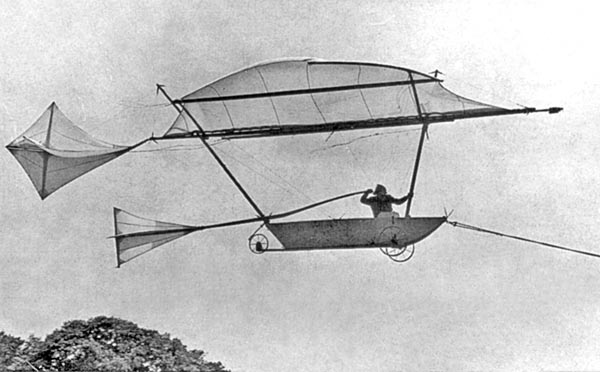George Cayley's replica "Governable Parachute" at Brompton, Scarborough.
The life of Sir George Cayley and what he did for aviation needs a full and proper website creating. In the meantime however I shall attempt to document one man's dedication to re-building aircraft to Cayley's original designs. John Sproule had first flown in gliders in the 1930s and worked for Fred Slingsby before the War. He had had a successful career in the Royal Navy and had retired in the late-1960s. He set about using Cayley's designs to properly re-construct exact replicas of Cayleys machines and had test flown them from the little dale in Brompton where Cayley had flown his original models. In 1971 he build the first of the replica's, the 1853 "Riding Rudder", a pilotless glider which he test flew at Brompton on 18th August 1971. He then built some of the earlier models of Cayleys. By the end of 1972 Anglia Television had shown an interest in making a documentary about Sir George Cayley's life and approached John Sproule about constructing the famous "Coachman" Governable Parachute Glider. The drawings were completed and the glider was constructed by Ken Fripp at Southdown Aero Services, Lasham, Hampshire. Sproule recruited a top glider pilot, Mr Derek Piggott, to be the pilot throughout the test flights and for the filming by Anglia Television.
On 10th July 1973 it had been test flown with success, the team de-camped to Holme on Spalding Moor airfield where the some of the flying shots were filmed. On 16th July 1973 they moved to Brompton to film the all important "coachman" scenes. The method of launch was to attach a bungee cord to the glider and the other end to either people or a car. Local people assisted in holding the glider's tail
while the people or the car drove off until the bungee was tight and the glider was released. Four short flights were made (with people acting as the tow) made it was agreed to attempt a longer and faster flight for the film (with the car as the tow). The glider reached a height of forty feet but as it reached the other side of the dale the nose dropped and the tail collapsed. It crashed and was damaged but the pilot was uninjured. The replica glider is now on show at the Yorkshire Air Museum.
Pilot - Mr Alan Derek Piggott.
Back to table.
CENTER>
Alan "Derek" Piggott was born in December 1922 and became one of Britain's most famous glider pilots and instructors. He had trained to fly aircraft in the War and received his commission on 3rd September 1943 to the rank of P/O on probation (emergency) but switched to pilot gliders in 1944. He later flew Dakotas in Burma and India. After returning to the UK he became an instructor at the Central Flying School of the RAF at Little Rissington. On 1st January 1955 he received the Queen's Commendation for Valuable Service in the Air. Having risen to the rank of F/Lt he relinquished his commission and left the RAF on 3rd May 1963 and became Chief Flying Instructor at the Lasham Gliding Society. He won many competions and awards for his civilian gliding. He also flew as a stunt pilot in films including Chitty Chitty Bang Bang. He was awarded the MBE on 13th June 1987 "for services to gliding" and has written a number of books about gliding. He featured in a more recent "Speed with Guy Martin" cycle-powered glider documentary where he was interviewed about a similar project he took part in some decades earlier. He died in 2019.
John Sproule, the man behind the rebuilding of Cayley's machines was born in October 1915 and was educated at the well regarded St.Peter's School in York. He later worked for Slingsby's at Kirkbymoorside where he was the designer behind the Kirby Cadet glider. Before serving in the War he worked for Airspeed and joined the Fleet Air Arm in 1940 but poor eyesight prevented him flying operationally. After the War he retrained to pilot early helicopters. He invented a device to attach helicopters to ships (still in use today), small signalling pistol holster following a ditching in a helicopter where he had no signalling device and a net used to scoop up people in the sea by a flying helicopter. He later commanded 701 Squadron before leaving the Navy in 1960 and worked for Agusta Helicopters. He died in 1994.